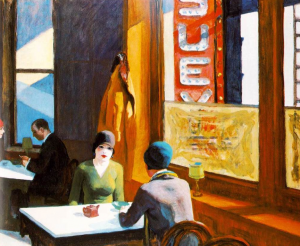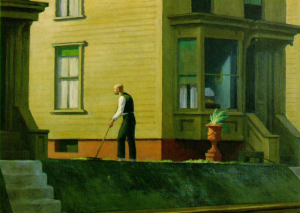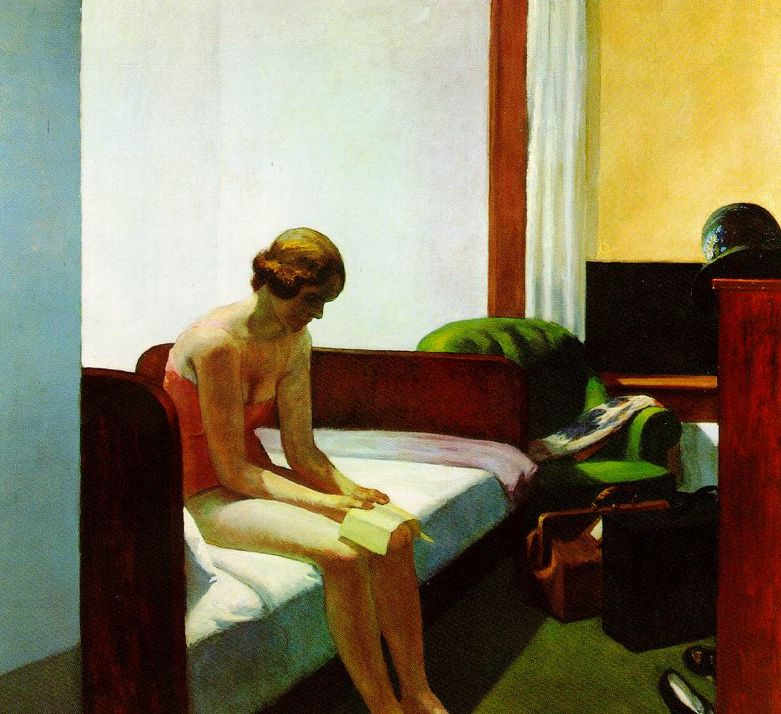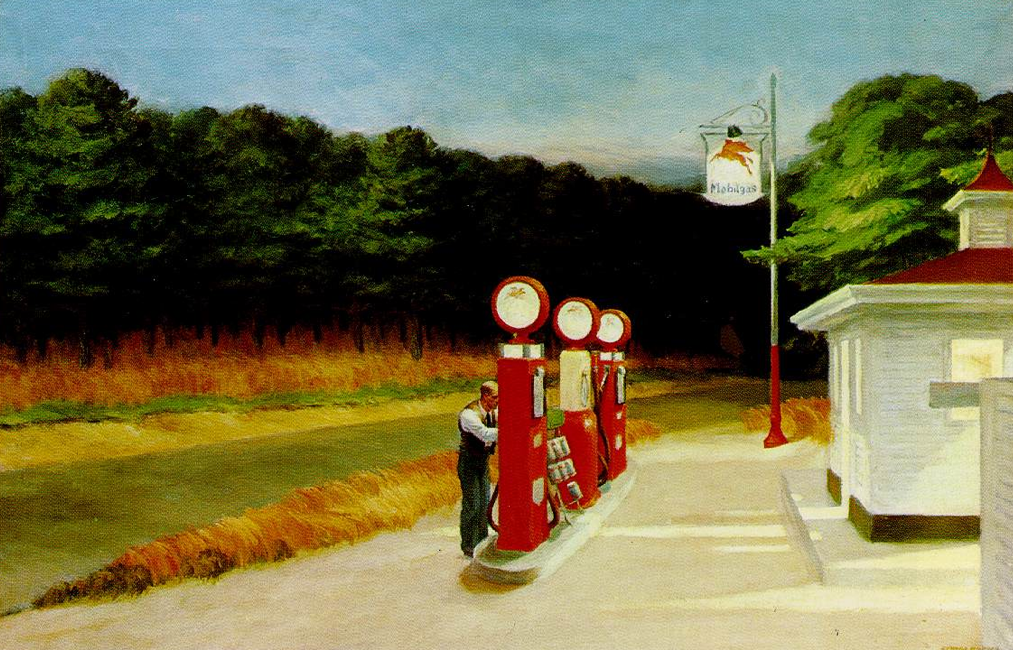version anglais en bas de la page…
Je ne sais pas ce qui se passe à Paris, mais j’ai l’impression que tout le monde est devenu amateur d’art avec des queues insupportables devant tous les musées de la ville. Il nous a fallu trois visites au Pompidou pour osé Dali, on a raté Guardi au Jacquemart André et c’est seulement grâce à une prolongation qu’on a pu voir Hopper ce weekend.
 On a quand même hésité. Avec les foules comme ça on n’a pas le temps de vraiment apprécier la collection. Mais je connaissais peu sur cet artiste et j’avais une grande curiosité. Et, la gourmande que je suis, j’étais motivée par nos réservations au Mini-Palais pour après l’expo.
On a quand même hésité. Avec les foules comme ça on n’a pas le temps de vraiment apprécier la collection. Mais je connaissais peu sur cet artiste et j’avais une grande curiosité. Et, la gourmande que je suis, j’étais motivée par nos réservations au Mini-Palais pour après l’expo.
L’oeuvre de Hopper est relativement petit, que 100 tableaux, 26 graveurs et une poignée d’aquarelles. Le tout est présenté en ordre chronologique, ce qui a démontré l’évolution de cet homme en tant qu’artiste.
Pour enrichir l’exhibition et démontrer le parcours de Hopper, les oeuvres de ses collègues et de ses amis, des artistes comme Degas et Pissarro sont exposés dans les premières salles. Ce sont les oeuvres qui ont influencé, enrichi et défini le travail de Hopper.
L’exhibition commence avec son apprentissage avec Robert Henri. Dans les tableaux mono-chromatique de son copain George Bellows on distingue déjà un intérêt pour l’architecture, la puissance de la géom’trie, la force de la solitude.
Après ses études Hopper se rend à Paris et rencontre l’Impressionisme. C’est ici sur Degas et Pissarro qu’il développe sa palette et étudie la lumière. Pour gagner sa vie, il travaille comme illustrateur publicitaire.
Hopper déclare que c’est en travaillant en graveur qu’il a trouvé sa voix et c’est dans cette salle qu’on voit la solitude sans relâche : l’homme qui surgit des ombres à côté des rails d’un chemin de fer, la maison isolée avec la silhouette d’un homme, deux pêcheurs sur un bateau seule face aux vagues. Et vous observez tout ce “seule” dans une petite pièce pleine de visiteurs. Vous êtes bousculé, poussé, entouré, mais infiniment seule. La juxtaposition est époustouflante.
Bientôt vous descendez et vous êtes avec ses tableaux, au peu près une quarantaine, ce qui êtes impressionnante pour une exhibition sur une artiste de cette importance. Et facilement, sans trop y réfléchir, vous observez d’autres thèmes. Chez Hopper, la lumière, elle est jaune, les ombres sont fortes et le vert est presque une personnage, tellement c’est présent dans son oeuvre. Il y a des angles, presque toujours un angle fort qui traverse le tableaux, montant de la gauche au droite. Et encore l’immobilité. Une danseuse burlesque semble être figée sur scène, son pianiste ne bouge pas, non plus.
Je n’ai vu qu’un seul toile avec du mouvement, The Bridle Path avec des chevaux qui courent vers un tunnel, les cavaliers anxieux et mal à l’aise. Ce n’est pas un grand tableaux et ça démontre bien pourquoi le meilleur de Hopper ne bouge pas. Ce qui est sans importance, parce que c’est l’émotion, une solitude sans pitié qui nous remoue chez ce grand artiste.
Last week a friend went to see the Hopper show and afterwards pronounced that she’d been very disappointed. The crowds were thick and there’d been very few paintings. This made me a bit hesitant about heading out into the cold on Sat night for our 20h30 reservations to see the show, but my instincts told me that this was an important show for me to see.
There was a lot of confusion at the entrance, with three separate queues for ticket holders, non-ticket holder and some swanky private party guests. I was starting to think that maybe I should listen to my friend and try to scam my way into the party, but this was a date with Mr French and that is not his style. We’d be doing what we’d set out to do; see the Hopper exhibition.
The format and layout of an exhibition are almost as important to me as the content of a show, and in this show, the presentation was nothing short of sensational from an intellectual perspective. The curator presented Hopper’s work chronologically, grouping everything by periods.
I could immediately understand why my friend felt their were few paintings; Hopper’s entire oeuvre is only 100 paintings, so the show starts out featuring the work of his friends, colleagues and collaborators. But, by the end of the show I had (very unscientifically) counted about 40 paintings, which means that those attending the show got to see a very large percentage of his work, which is incredibly rare for a show featuring an artist of Hopper’s importance.
 First, there is his work as a student with Robert Henri and when you see the monochromatic grey paintings of his fellow classmate George Bellows, you suddenly start to “get” Hopper. Then there is the art from his Paris years. Unexceptional, except this is where he really seemed to master his sense of lines and boundaries. And you can clearly see the influence of his impressionist friends Pissarro and Degas on both his subject matter and his palette.
First, there is his work as a student with Robert Henri and when you see the monochromatic grey paintings of his fellow classmate George Bellows, you suddenly start to “get” Hopper. Then there is the art from his Paris years. Unexceptional, except this is where he really seemed to master his sense of lines and boundaries. And you can clearly see the influence of his impressionist friends Pissarro and Degas on both his subject matter and his palette.
You then see his work as a commercial illustrator, followed by his first American paintings. Again, there are paintings by the friends and colleagues that inspired and influenced his work and it is at this moment that I started to see a theme; solitude. All the influences in Hoppers art and nearly of all of his subjects, from two sailors at sea to a solitaire home, from a person emerging up next to railroad tracks to the customers at a coffee shop in his seminal work, Nighthawks, Hopper’s work defines alone.
The show has drawn over half a million visitors and as you strain to study the etchings that helped him find his “voice” as an artist you are jostled by a tight crowd, bumping into people every where you turn, yet absolutely surrounded by alone. It is a impressive juxtaposition.
As the show continues, so does the solitude. And you may start to notice other themes. In Hopper’s world, light is yellow and shadows are clearly delineated. Green is every where, always brightly toned, in a multitude of hues from kelly green grasses to lichen green wall paper. Life exists at a tilt with sharply illustrated diagonals, general one very clear diagonal per image, often running up, from left to right. And finally, the stillness. Even a burlesque dancer in the Girlie Show looks completely still, although her arm is raised and she is clearly on stage.
The only painting with any serious movement, The Bridle Path, is of three horses racing into a tunnel, their riders looking awkward and reticent to advance. It is not a great painting and does a lot to show why Hopper’s best work is absolutely devoid of any motion. But not Emotion. Hopper’s painting are full of that; solitude and loneliness abound and it is this intense feeling he provokes in the viewer that makes him a great artist.



Great posting. Is Nighthawks in Paris? I hadn’t noticed it missing from the Art Institute, but since you’ve also taken my favorite Caillebotte painting, you might as well have a Hopper too.
Yes, we’ve got ’em both. Mwoahhhh!!! Paris NYC Chicago seem to have something of an artistic menage à trois going on…
Wait, which Caillebotte painting? I have two favorites – (don’t know the exact titles) – the floor scrapers and the rainy day.
The Chicago Art Institute has loaned “Rue de Paris” (aka rainy day) to the Orsay for the fashion in Impressionism exhibit. And last time I checked, Les Raboteurs (the floor scrapers) was not on the walls at the Orsay. However, since they recently renovated, I don’t know if its on loan, or if I missed it in its new location. I love that painting, so I did keep my eye out for it!